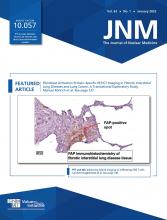Discussions with leaders: Czernin and Herrmann interview Rodney Hicks about his 3 decades of practice, research, and clinical trial achievements in advancing nuclear medicine in Australia.
Page 1
α-emitter labeling review: Yang and colleagues provide a state-of-the-art overview of methods for incorporation of α-emitting isotopes into radiopharmaceuticals, with a focus on new discoveries and remaining challenges.
Page 5
Imaging ICI-induced myocarditis: Rischpler and colleagues look at the potential for nuclear medicine imaging techniques in detecting early immune-related adverse events after immune checkpoint inhibitor therapy.
Page 14
Molecular breast imaging: Covington and colleagues highlight current instrumentation, indications, and clinical applications for breast-specific γ imaging and describe likely future innovations.
Page 17
AR imaging with 18F-FDHT PET: Jacene and colleagues explore imaging of androgen receptors with 18F-fluoro-5α-dihydrotestosterone PET in patients with estrogen receptor–positive metastatic breast cancer receiving selective androgen receptor modulation therapy.
Page 22
Assessing CLI: olde Heuvel and colleagues evaluate the accuracy of Cerenkov luminescence imaging after 68Ga-prostate-specific membrane antigen injection in intraoperative margin assessment during prostatectomy and investigate the characteristics of the resulting chemiluminescence signal.
Page 29
First-in-human 11C-glutamine PET: Cohen and colleagues report on the radiologic safety and biodistribution of this tracer designed to study glutamine uptake and metabolism with PET in a group of patients with confirmed metastatic colorectal cancer.
Page 36
Targeting PARP-1 in ovarian cancer: Young and colleagues characterize the pharmacokinetics of 18F-fluorthanatrace and test kinetic and static models to guide metric selection in future studies of this tracer as a biomarker of response to poly-(adenosine diphosphate-ribose) polymerase–inhibitor therapy.
Page 44
c-MET fluorescence penile cancer imaging: de Vries and colleagues present the first results of a prospective feasibility study for real-time intraoperative visualization of penile squamous cell carcinoma using a fluorescent mesenchymal–epithelial transition factor receptor–targeting tracer.
Page 51
90Y versus systemic therapy: Salem and Gabr offer perspective on current clinical practice and national trends in transarterial radioembolization and systemic therapy for hepatocellular carcinoma.
Page 57
AUC for PSMA PET: Jadvar and a multidisciplinary working group provide detailed appropriate use criteria and decision-making scenarios for prostate-specific membrane antigen PET imaging in prostate cancer.
Page 59
Dual-tracer PET/CT in CRPC: Chen and colleagues determine the added value of 18F-FDG PET/CT imaging to that of 68Ga–prostate-specific membrane antigen PET/CT in patients with castration-resistant prostate cancer and identify patients who may benefit from dual-tracer imaging.
Page 69
EAU risk groups and PSMA PET stage: Ferdinandus and colleagues look at rates of local and metastatic disease on prostate-specific membrane antigen PET in biochemical recurrence and persistence of prostate cancer as stratified by European Association of Urology risk guidelines.
Page 76
68Ga-FAPI PET/MR in gastric cancer: Qin and colleagues describe the performance of 68Ga-DOTA-FAPI-04 PET/MR for diagnosis of primary tumor and metastatic lesions in patients with gastric carcinomas and compare results with those from 18F-FDG PET/CT.
Page 81
68Ga-FAPI PET in sarcoma: Kessler and colleagues report on the endpoints of a 68Ga-FAPI PET prospective observational trial in patients with bone or soft-tissue sarcomas, including histopathologic comparisons and validation of diagnostic imaging.
Page 89
CXCR4 imaging in MPN: Kraus and colleagues detail the feasibility of C-X-C motif chemokine receptor 4–directed imaging with PET/CT using 68Ga-pentixafor to visualize and quantify disease involvement in patients with myeloproliferative neoplasms.
Page 96
Dose–response and peptide-receptor radionuclide therapy: Tamborino and colleagues build a refined dosimetry model for 177Lu-DOTATATE preclinical experiments enabling correlation of absorbed dose with double-strand break induction and cell death.
Page 100
18F-Flortaucipir and 18F-MK-6240 PET: Gogola and colleagues directly compare brain distribution, specific signal, and off-target binding of these 2 frequently used PET tau tracers in elderly individuals with varying clinical diagnoses and cognition.
Page 108
β-Amyloid PET signal source: Biechele and colleagues report on 2 murine cerebral amyloidosis models that present with distinct β-amyloid plaque compositions and explore the respective biochemical contributions to Aβ PET signal in vivo.
Page 117
68Ga-FAPI-04 PET/CT for fibrosis imaging: Schmidkonz offers perspective on fibroblast activation protein–specific PET/CT in fibrotic interstitial lung diseases and previews a related article in this issue of JNM.
Page 125
68Ga-FAPI PET/CT in fILD and LC: Röhrich and colleagues evaluate the imaging properties of static and dynamic fibroblast activation protein inhibitor PET/CT in various types of fibrotic interstitial lung disease, including preclinical assessments and studies in human biopsy samples.
Page 127
Post–COVID-19 vaccine PET/CT: Eifer and colleagues detail PET/CT uptake in the deltoid muscle and axillary lymph nodes of patients who received a COVID-19 mRNA-based vaccine and evaluate its association with patient age and immune status.
Page 134
18F-FAraG imaging of CNS T cells: Guglielmetti and colleagues explore the potential of 2′-deoxy-2′-18F-fluoro-9-β-d-arabinofuranosylguanine PET imaging to assess infiltrating T cells in multiple sclerosis and to provide, in combination with MRI, a novel tool to determine lesion types.
Page 140
18F-FDOPA radiomics in gliomas: Zaragori and colleagues determine whether a range of 18F-FDOPA PET radiomics feature sets improve 18F-FDOPA PET imaging performance as an adjunct to MRI and describe the contributions of each of the features.
Page 147
AI for coronary PET and CT angiography: Kwiecinski and colleagues combine coronary 18F-sodium fluoride PET and CT angiography–based quantitative plaque analysis to develop an optimal machine-learning model for risk prediction of myocardial infarction in patients with stable coronary disease.
Page 158
- © 2022 by the Society of Nuclear Medicine and Molecular Imaging.







